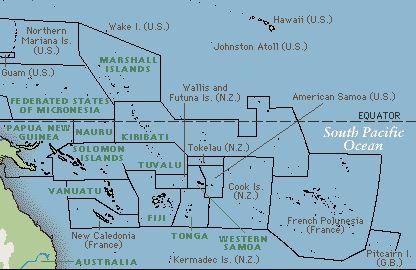 |
 |
Do you want to know where Oceania is? OK. Take a world map, for a start. Now, look at the Pacific Ocean: it is the blue part between America and Asia: do you see a big island in the south-west of the Ocean and a lot of island mostly north-east of the big island? There it is.
If you have a good map and try counting all the islands in Oceania, you might be hours counting them, as there are more than 10,000 islands. And we are talking here of Oceania in its most restricted meaning.
According to the Encyclopedia Britannica, the term Oceania, in its widest sense, embraces the entire insular region between Asia and America. That means including Japan, Indonesia, Taiwan and the Philippines, besides many other smaller islands. But in our Oceania Project we will respect most popular usage, but exclude Australia.
Apart from Australia, the continent of Oceania is divided into three parts: Melanesia, Micronesia and Polynesia.
Melanesia's islands are the nearest to Australia, moving toward the north-east: New Guinea, the Bismarck and Solomon islands, New Caledonia, Vanuatu, Fiji. These islands are prone to cyclones and earthquakes. The highest mountain in Oceania is here: Puncak Jaya (5,030 m), in New Guinea.
Micronesia is north of Melanesia. The islands in Micronesia are very small and include the Marshall, Kiribati, Caroline and Marianne groups.
Polynesia is the eastern part of Oceania. Aotearoa (New Zealand) is the biggest land mass; Hawai'i, French Polynesia, Samoa, Tonga, Cook Islands and Easter Island are also in Polynesia. There are very high volcanos, mostly in Hawaii: Mauna Kea (4,208 m) and Mauna Loa (4,170 m) are the highest.
Looking again at the general map of Oceania, you will notice this continent's colour is mostly blue. The name of the continent really matches its nature: there is much more ocean than land. If we put all the islands together except for Australia, we will get a total land area of approximately 821,000 square km (317,000 square miles). Australia itself is nine times that size. And we need a dozen Oceanias to reach the size of Europe.
But the size of the land doesn't make a place great, as you will learn for yourself when you read our pages, where...
Now sit back and enjoy the trip!
| on to... |
| Write to Imanol or Alan
at oceania@eirelink.com
-- we'd love to hear from you! You are visitor number Aloha! Arohanui! Lukim yu! Parahi! Sa moce! Agur! ©
Éire Language and
Information Services, 1997
|